I can use dogs to locate nesting hens easily as they hold point on a given nest until told to move on. What I want to do is rapidly locate nest using an aerial drone that flies a pattern over an area then feeds back and records images with GPS data attached.That would be a great project. There are means of locating birds in the wild but triangulation is needed and of course the bird has to have a small unit attached.
Eventually sender units will be developed that are small enough and light enough for birds. The advantage is you only need a single portable receiver.
Such a setup would save me hours of searching for hens that have nested away from the coops.
Good luck with the project.
Navigation
Install the app
How to install the app on iOS
Follow along with the video below to see how to install our site as a web app on your home screen.
Note: This feature may not be available in some browsers.
More options
You are using an out of date browser. It may not display this or other websites correctly.
You should upgrade or use an alternative browser.
You should upgrade or use an alternative browser.
Cooperative Behavior?
- Thread starter Shadrach
- Start date
- Thread starter
- #52
Not the greatest pictures but this is Knock.
It's now dark and all the other chickens are in their coops.
I've posted these to show there is no doubt that she is sitting.


As I've mentioned above, neither Cillin or Treacle have mated with this pullet.
I've done my best to document with pictures and words the events that led up to this point.
The roosters in the two tribes did cooperate to get Knock safely from her tribe to her nest site. There were no forced matings, no fights between roosters or rooster and cockerel.
Unfortunately it just isn't practicable to let Knock hatch her clutch.
This small tale doesn't prove anymore than under the circumstances here roosters from two different and competing groups cooperated. It's taken nine days of roughly a minimum of two hours a day to observe these events.
To the best of my knowledge there has been no other documented observation of this behavior. Current theory has it that the roosters from competing groups would have fought, or forced this hen to mate. It is particularly interesting given the cockerel who has no hens of his own and is in full mating mode didn't molest this hen in any way.
There is more research being done on chicken behavior but we have such a long way to go before people will accept that chickens are intelligent and highly social creatures.
It's now dark and all the other chickens are in their coops.
I've posted these to show there is no doubt that she is sitting.
As I've mentioned above, neither Cillin or Treacle have mated with this pullet.
I've done my best to document with pictures and words the events that led up to this point.
The roosters in the two tribes did cooperate to get Knock safely from her tribe to her nest site. There were no forced matings, no fights between roosters or rooster and cockerel.
Unfortunately it just isn't practicable to let Knock hatch her clutch.
This small tale doesn't prove anymore than under the circumstances here roosters from two different and competing groups cooperated. It's taken nine days of roughly a minimum of two hours a day to observe these events.
To the best of my knowledge there has been no other documented observation of this behavior. Current theory has it that the roosters from competing groups would have fought, or forced this hen to mate. It is particularly interesting given the cockerel who has no hens of his own and is in full mating mode didn't molest this hen in any way.
There is more research being done on chicken behavior but we have such a long way to go before people will accept that chickens are intelligent and highly social creatures.
This from a few years back. Not scenic, but what I have to deal with here. She was associated with a harem master, another pullet American Dominique coming into lay, and a satellite American Dominique. I had two genetic markers allowing detection of cuckoldery. First was with respect to egg color. Hen shown produced eggs with white shells while the other slipping eggs in to same nest had brown egg shells. Based on appearance of chicks, I could also determine identity of fathers. Those the harem master and this female had chipmunk stripes. Those produced by other female and harem master where solid black if female and barred like a female American Dominique if male. This hen produced one daughter out of about 18 eggs hatched that was sired by the satellite. I never saw the satellite cover her, but evidence in genes of chicks says he did at least once.

She started incubation cycle while snow still present. Her world was decidedly white and brown.
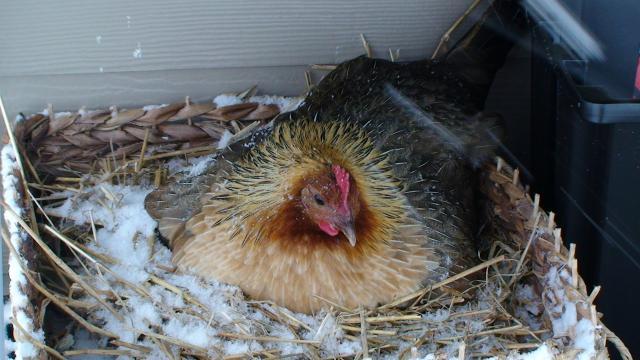
She started incubation cycle while snow still present. Her world was decidedly white and brown.
Here is where I had your typical escort service going on although only the harem master was involved. Chick had finely weaned the day prior and stayed with harem master most of time when hen went to deposit an egg. The satellite was no longer able to interact with hen this go around.

Notice variations in vegetation. I purposely left strips unmowed to serve as bio-attractor for insects to collect in.
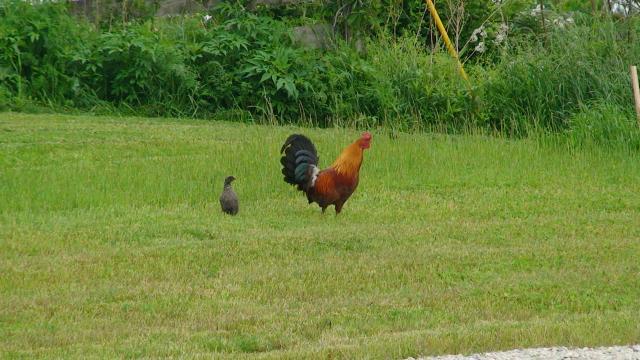
Notice variations in vegetation. I purposely left strips unmowed to serve as bio-attractor for insects to collect in.
Here is a closer to more natural social groupings I realize. Two hens and their offspring of the season.


By this point in breeding season the cock / harem master is invested more in the offspring than hens.

We also had some interspecies associations as well.

My "multi-coop" system was at one point based on these debacles. Better to say multi-roost with this. Even had a bunch roosting in a tree to left of image.

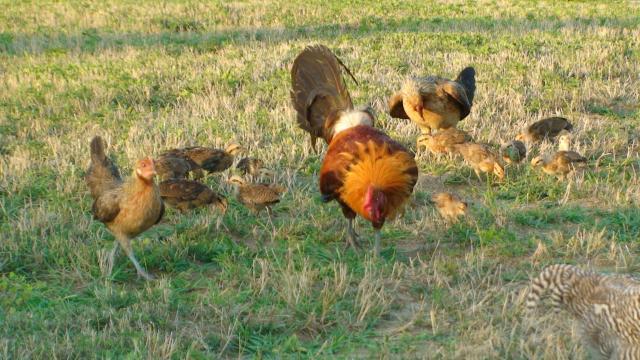

By this point in breeding season the cock / harem master is invested more in the offspring than hens.
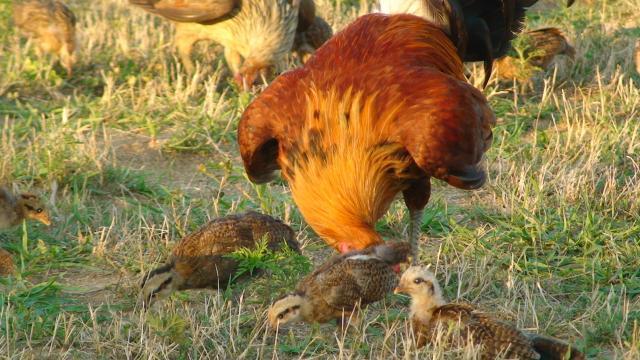
We also had some interspecies associations as well.
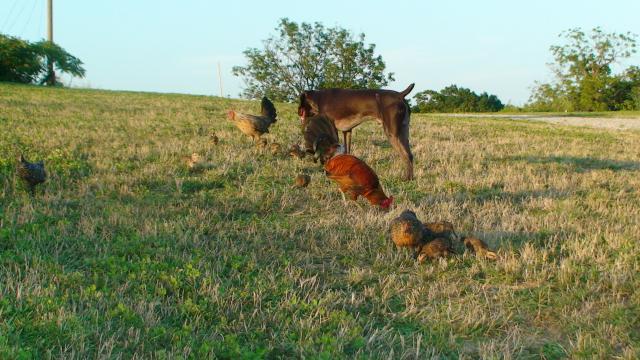
My "multi-coop" system was at one point based on these debacles. Better to say multi-roost with this. Even had a bunch roosting in a tree to left of image.
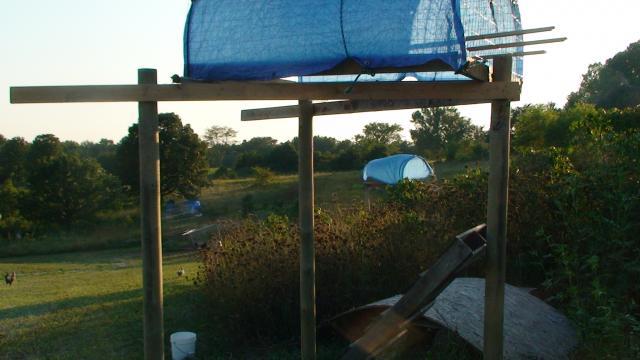
Last edited:
Spent last hour trying to find these two images. Hen above put her third clutch of season in there. See it?

Now you do. It is in the clump of grass over a small mound of soil.

Crows found this one just before she committed to incubation so clutch lost. No biggy, she produced well over 100 chicks in the following 6 years.
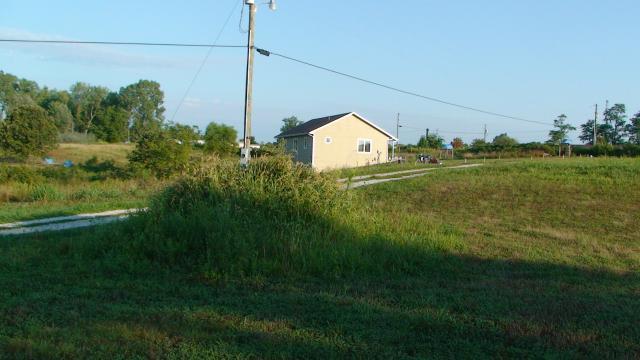
Now you do. It is in the clump of grass over a small mound of soil.
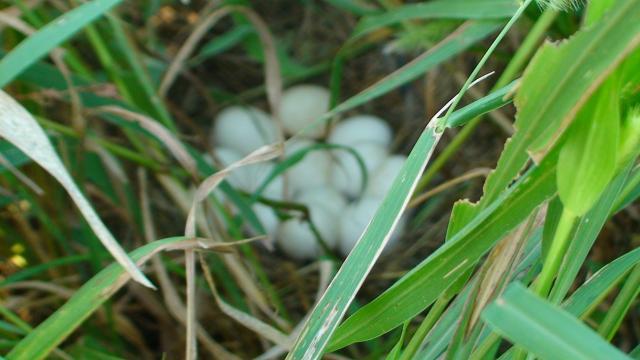
Crows found this one just before she committed to incubation so clutch lost. No biggy, she produced well over 100 chicks in the following 6 years.
- Thread starter
- #57
Some great pictures there centrarchid.
The only time I’ve had two mothers and chicks here at the same time it ended up in a bit of a brawl between the mothers.
They were from different tribes though and as usual the brawl seemed to be over access to resources which in this case was best cover territory.
Love the picture of dad child minding. Most of the literature I’ve read about the males role in chick rearing says it doesn’t happen. I certainly see fathers minding the chicks and obviously you do to.
What has happened here a few times is if there is a junior/satellite rooster or cockerel they get the child care job once the mother has stopped feeding the chicks.
Your nest site pictures are much like the nest sites away from the coops I get here. Tall grass is always worth investigating. I suppose if you contain chickens in a run then the usual nest box arrangement is the only and therefor the best option.
Most chicken keepers on this mountain that I know of (the vast majority free range) don’t even bother making nest boxes; the chickens would rather just about any other site.
My multi coops are really just fortified versions of yours. Essentially they are sheltered roost bars and have nothing like the 4 foot per fowl space recommended here.
The only time I’ve had two mothers and chicks here at the same time it ended up in a bit of a brawl between the mothers.
They were from different tribes though and as usual the brawl seemed to be over access to resources which in this case was best cover territory.
Love the picture of dad child minding. Most of the literature I’ve read about the males role in chick rearing says it doesn’t happen. I certainly see fathers minding the chicks and obviously you do to.
What has happened here a few times is if there is a junior/satellite rooster or cockerel they get the child care job once the mother has stopped feeding the chicks.
Your nest site pictures are much like the nest sites away from the coops I get here. Tall grass is always worth investigating. I suppose if you contain chickens in a run then the usual nest box arrangement is the only and therefor the best option.
Most chicken keepers on this mountain that I know of (the vast majority free range) don’t even bother making nest boxes; the chickens would rather just about any other site.
My multi coops are really just fortified versions of yours. Essentially they are sheltered roost bars and have nothing like the 4 foot per fowl space recommended here.
Within social groups, the conflicts are usually minimal, or worked out before nest site is even selected. Hens of rival groups seldom get to settle differences because harem master intervenes and drives off the outsider, although he will sometimes mate her in the process.Some great pictures there centrarchid.
The only time I’ve had two mothers and chicks here at the same time it ended up in a bit of a brawl between the mothers.
They were from different tribes though and as usual the brawl seemed to be over access to resources which in this case was best cover territory.
Love the picture of dad child minding. Most of the literature I’ve read about the males role in chick rearing says it doesn’t happen. I certainly see fathers minding the chicks and obviously you do to.
What has happened here a few times is if there is a junior/satellite rooster or cockerel they get the child care job once the mother has stopped feeding the chicks.
Your nest site pictures are much like the nest sites away from the coops I get here. Tall grass is always worth investigating. I suppose if you contain chickens in a run then the usual nest box arrangement is the only and therefor the best option.
Most chicken keepers on this mountain that I know of (the vast majority free range) don’t even bother making nest boxes; the chickens would rather just about any other site.
My multi coops are really just fortified versions of yours. Essentially they are sheltered roost bars and have nothing like the 4 foot per fowl space recommended here.
The paternal behavior of the American Games appears particular to games. I do not think it comes from the Red Jungle Fowl part of their ancestry as little more than tid-bitting and predator avoidance is listed for roosters of the nominal species in the literature. Chickens are not Red Jungle Fowl owing to hybridization and intensive selection on those hybrids. I have encountered a statement that appears to come from a biologist that indicated adult male Grey Jungle Fowl do help care more for offspring after hen weans, but cannot find a reviewed statement.
Selective pressure for the games has likely been intensive for millennia with respect to care of offspring. Certainly the way my forefathers kept breeding groups is consistent with that. The penning adult birds up singly year round (I do a lot of that too now) is a much more recent development making so parties using exclusively that system are ignorant of what their birds are capable of. Got to watch that, ignorance breeds contempt.
My elevated roosts were not treated as coops at all, rather they were more about being simply places to sleep with minimal interference from rain and Great-horned Owls. Being high made it harder for ground predators and the dog made really hard. It was during interval with the elevated coops my dogs caught Red Foxes and killed them. Ground nesting hens I covered with chicken tractors at night as knew where all were located.
Nesting boxes are still most reliable. A large percentage of clutches on ground drown when you get heavy rain events.
Last edited:
- Thread starter
- #59
Knock spent the night in the next box in my house.
This morning she got up and went to look for food, water, and bath. She spent an hour, or so away and this is the story of her return to her nest.
Tribe 1 foraging as Notch and Knock approach (top right)

Cillin moves hens away from approaching Notch.

Cillin goes to meet Notch and Knock. Notice they are posturing to fight.

Poor little Knock in between just wanting to get to her nest.

Cillin stopping Notch from coming closer.

Notch backs away with Knock and the hens gather around Cillin again.

Cillin gives an alarm call.

There is a hawk just above the tree line but the camera didn't get it.

Cillin stands guard while Knock makes a dash for it.

Hens sought cover and Cillin watches knock (not in picture) running for my house.

Knock keeping close to the fence as she runs.

Treacle following behind.

A while later Notch with his hens.

And back in the jungle Tribe 2 bunch as the same hawk passes over the donkey field below.
 with her tribe and the pictures below are of Knock returning to the nest box.
with her tribe and the pictures below are of Knock returning to the nest box.
This morning she got up and went to look for food, water, and bath. She spent an hour, or so away and this is the story of her return to her nest.
Tribe 1 foraging as Notch and Knock approach (top right)
Cillin moves hens away from approaching Notch.
Cillin goes to meet Notch and Knock. Notice they are posturing to fight.
Poor little Knock in between just wanting to get to her nest.
Cillin stopping Notch from coming closer.
Notch backs away with Knock and the hens gather around Cillin again.
Cillin gives an alarm call.
There is a hawk just above the tree line but the camera didn't get it.
Cillin stands guard while Knock makes a dash for it.
Hens sought cover and Cillin watches knock (not in picture) running for my house.
Knock keeping close to the fence as she runs.
Treacle following behind.
A while later Notch with his hens.
And back in the jungle Tribe 2 bunch as the same hawk passes over the donkey field below.
Attachments
Last edited:
Knock spent the night in the next box in my house.
This morning she got up and went to look for food, water, and bath. She spent an hour, or so.
Tribe 1 foraging as Notch and Knock approach (top right)
Poor little Knock in between just wanting to get to her nest.View attachment 1652689
Does the location where the two harem masters are displaying coincide with a do not cross line / territorial boundary? Mine would engage in brief little chases back and forth with no actual contact between the roosters. Crossing would lead to contact.
Can you make video clips of their interactions when displaying? You will be able to hear some really cool sounds produced if close enough.
New posts New threads Active threads
-
Latest threads
-
-
My 6 Month Old Disabled Roo Morty; genetic or injury? Consistent Issue :(
- Started by PlagChickenDoc
- Replies: 1
-
-
-
Call duck eggs alive but with black spots?
- Started by JuliannaM06
- Replies: 0
-
-
Threads with more replies in the last 15 days
-
-
-
-
Chicken Butt Emergency ‼️ Please Help!
- Started by urlocalcrazychickenlady
- Replies: 69
-
Open Contest BYC Poultry Caption Contest 11-28-25 Pic by Ponypoor
- Started by TwoCrows
- Replies: 54
-
×


